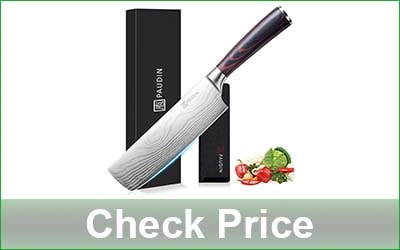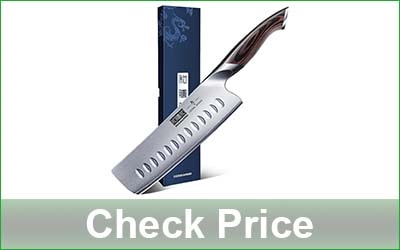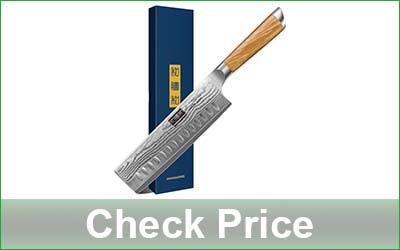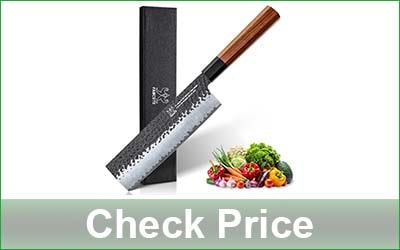I tested 15+ Nakiri knives under $50 after analyzing 31+ options. These top picks are based on real-world use and deliver reliable quality, performance, and value.
Best Nakiri Knife Under $50 – Comparison Table
| Product | Best For |
|---|---|
| 1. PAUDIN 7″ HC 5Cr15Mov Steel Nakiri Knife | Best-Selling |
| 2. HOSHANHO 7″ Japanese 10Cr15CoMoV HC Steel Nakiri Knife | All-Purpose |
| 3. HOSHANHO 6.5″ VG-10 Damascus 66-Layer Steel Nakiri Knife | High-Quality |
| 4. FAMCÜTE 7″ Japanese 9CR18MOV HC Steel 5-layer Vegetable Nakiri Knife | Budget-Friendly |
Best Nakiri Knife Under $50
1. PAUDIN 7-Inch High Carbon 5Cr15Mov Stainless Steel Nakiri Knife
My Nakiri knife arrived exactly on time, packaged in a sturdy black box with a slim sheath. It looked flawless, razor sharp, beautifully finished, and completely free from scratches or marks.
Blade: The 7-inch high carbon 5Cr15Mov stainless steel blade features a wave pattern that helps reduce food sticking. Out of the box, it was razor sharp and ready to use.
Over months of use, I’ve cut large items like Boston butts, whole chickens (avoiding bones), and watermelons, all with clean, precise slices. For medium tasks, I regularly cube chicken breasts for my dog’s meals without shredding.
Smaller jobs like trimming asparagus, slicing onions, carrots, garlic, and tomatoes feel almost effortless. The flat blade works best with an up-and-down motion, and I love scooping chopped ingredients straight into the pan.
After months, it keeps a good edge with light honing. A medium grit whetstone works best for restoring razor sharpness.
Handle: The pakkawood handle feels smooth and sturdy, fully integrated with the blade’s bolster and end cap for durability. It’s full tang, with good balance that keeps my wrists from tiring during long prep.
The craftsmanship is clean, with no gaps for food to get trapped. Its size fits both my larger hands and my spouse’s smaller ones. The slightly tapered shape provides a secure and comfortable grip, whether wet or dry.
Sheath and Box: The slim sheath protects the blade in storage, and the gift box adds a nice touch for gifting or safekeeping.
Maintenance: I always hand wash and dry immediately. Never using a dishwasher keeps it looking sharp with no rust spots.
Pros
- Cuts meat and veggies cleanly
- Edge stays sharp even after months
- Simple to clean and maintain daily
- Pakkawood handle feels secure in hand
- Lightweight design with balanced performance
- Comfortable fit for larger hand sizes
- Lifetime warranty with money-back guarantee
- Excellent quality at an affordable price
Cons
- Protective sheath feels a little thin
- Laser-engraved pattern isn’t real Damascus
2. HOSHANHO 7-Inch Japanese High Carbon Stainless Steel Nakiri Knife
My knife arrived right on time, packed securely in a deep blue presentation box with a protective foam lining that kept the blade safe. When I opened it and held the knife for the first time, I was genuinely impressed by how hefty and well-balanced it felt in my hand. There were no nicks or scratches, the blade looked flawless and every bit as sharp as I’d hoped.
Blade: The blade on this Nakiri is made from Japanese 10Cr15CoMoV high carbon stainless steel, measures 7 inches long, and is heat-treated to a hardness of 60 HRC. The edge came razor-sharp straight out of the box, hand-polished to a fine 15-degree angle.
Over several weeks, I used it heavily on dense veggies like sweet potatoes, carrots, thick cuts of steak, and a whole chicken, the knife sliced through each with hardly any effort. The blade’s weight and deep profile made push-cutting through watermelons or cabbage a breeze, and even tougher tasks like prepping butternut squash felt easier than with my other Nakiri knives.
For smaller jobs, I used it on onions, garlic, and fruits. I was impressed with how easily it handled delicate, paper-thin cuts like dicing onions or slicing strawberries and green peppers, keeping the slices stacked without scattering. The scalloped hollow design kept sticky foods from clinging, and the wide blade made scooping and transferring ingredients easy, something I really appreciated when prepping big batches of produce. It feels like a cross between a Nakiri and a small cleaver.
After weeks of daily use and all that chopping, the edge stayed sharp enough for precise cuts. I plan to keep it in top shape with my 1000/4000 grit whetstone that’s best suited for high carbon steel.
Handle: The handle is made from pakkawood and feels smooth with an elegant natural grain. The craftsmanship looks great, with no gaps, rough spots, or sharp edges. The smooth bolster, end-cap and seamless blade-to-handle connection feel solid and make it easy to keep clean and sanitized. It’s slightly front-heavy but still well-balanced with the full tang running through the blade, and it’s not enough to cause any wrist fatigue.
I love how the ergonomic shape of the handle fits naturally in my grip. It does feel slightly larger, but the slanted bolster adds extra security and control, even when my hands are wet or sweaty. I never feel it slipping. Overall, it’s a great handle that gives me confidence when working through bigger batches of ingredients.
Maintenance: I always hand wash this knife right after use and never put it in the dishwasher. With that simple care, I’m sure the blade will stay in great condition for a long time.
Pros
- Great for veggies, meat, fruit, anything
- Every cut felt controlled and clean
- Holds edge well after heavy use
- Scalloped design prevents food sticking
- Handle feels smooth, polished & comfortable
- Good weight and balance for control
- Great for handling both big and small tasks
- Comes with warranty coverage
- Far better quality compared to the price
- Best Nakiri vegetable knife under $50
Cons
- Handle can feel large for some
- Slightly heavy for long prep sessions
- Not dishwasher safe, handwash only
- No protective sheath included for storage
3. HOSHANHO 6.5-Inch VG-10 Core with 66-Layer Damascus Stainless Steel Nakiri Knife
My new veggie knife arrived right on time, tucked safely inside a beautiful deep blue box that felt premium and gift-worthy. The blade was wrapped in protective plastic with sturdy guards, and it looked flawless when I first took it out.
Blade: The blade on this one is a 6.5-inch Japanese VG-10 core wrapped in 66 layers of Damascus steel; you can see the genuine wave patterns, no fake engraving here. The blade is heat-treated to 62 HRC, and hand-sharpened to a precise 15° edge. Straight out of the box, it felt sharper than any other knife I’ve owned.
Over the last few weeks, I’ve put it through some serious chopping sessions. For bigger jobs, I started with whole cabbages, pumpkins, and sweet potatoes; the cuts stayed controlled and clean, almost effortless, with hardly any food sticking to the sides thanks to the anti-stick grooves. Carrots and cucumbers are my daily snack, so I slice up pounds of them every week; this blade glides right through without cracking or shredding them.
On the lighter side, I tested it on onions, ginger, and garlic cloves; each slice is clean and precise. It also sliced cherry tomatoes, bell peppers, green peppers, and herbs into thin pieces without tearing their skins. I even butterflied chicken breasts to check how it handles protein; it sliced through like warm butter. It’s not my catch-all kitchen blade, but when it comes to veggies and boneless meats, it’s become my go-to tool for daily prep.
After weeks of daily chopping, this blade still holds its razor edge with no signs of dulling. When it’s time, a whetstone like a 3000/8000 grit works best for the VG-10 steel.
Handle: The olive wood handle shows off the craftsmanship; it’s well-made with a polished, smooth finish and clean transitions between the bolster, end-cap, and handle; there are no rough edges or gaps to trap food. It’s full tang and perfectly balanced with a comfortable weight that gives me good control, even when I’m chopping for a while.
The handle shape fits naturally in my hand, not too thick or too thin, and there’s no awkward tilting. It feels nimble and just right. I can chop for long stretches without any slipping or discomfort, whether my hands are wet or dry.
Maintenance: I always hand-wash and dry this one right after use to keep the wood handle looking great. Definitely keep it out of the dishwasher, it’s just too nice to risk.
Pros
- Genuine 66-layer Damascus steel blade
- Made in Japan (steel origin)
- Handles meat, soft, or hard veggies
- Anti-stick grooves keep food from sticking
- Stays sharp for months without honing
- Olive wood handle feels balanced, beautiful
- Full tang build feels solid, strong
- Easy to maneuver, making fast slicing
- Affordable price for premium knife quality
- Backed by reliable warranty and support
Cons
- Not dishwasher safe, hand wash only
- Better for veggies than hard bones
- Needs careful drying after washing
4. FAMCÜTE 7-Inch Japanese 9CR18MOV High Carbon Stainless Steel 5-layer Vegetable Nakiri Chef Knife
My knife arrived right on time in a lovely black cardboard box, fully wrapped and perfectly intact. The packaging felt almost premium, like unboxing a new phone. Inside, the blade looked sharp and clean, plus it came with a handy microfiber cloth.
Blade: The 7-inch blade is made from hand-forged, 5-layer Japanese 9CR18MOV high carbon stainless steel, and right out of the box, I could tell it was razor sharp. I really like how the slightly thicker blade feels closer to a German knife, so it’s sturdy but still slices like a Japanese style blade.
I’ve tested this Nakiri for weeks now, and it’s handled big veggies like dense sweet potatoes, large carrots, giant bell peppers, and even brisket – no struggling to cut thru, slicing them all in one go. It glides through smoothly every time, speeding up my chopping without sticking. Cutting a huge watermelon was easy too, thanks to the blade’s weight and sharpness doing the work for me.
For everyday fruits and veggies, I’ve sliced tomatoes, mushrooms, strawberries, apples, and lemons almost paper thin, and even delicate herbs like cilantro stay neat. Dicing ginger, garlic, and onions is quick, with no crushing. Small tasks like trimming chicken breasts or deboning wings felt just as effortless. Cutting fish is smooth, no sawing needed, just clean slices.
I’ve been using it daily for a few weeks now, and the edge has stayed sharp with no chips. I keep it in top shape with a 1000/6000 grit whetstone, which works best for this Japanese high carbon steel.
Handle: The rosewood handle feels as good as it looks. The handle is finished smoothly with no rough edges, and the whole thing feels sturdy and well-crafted. Its octagonal shape gives me a secure grip, even when my hands are wet, and I never feel it slip.
The balance between the handle and blade is just right, so it doesn’t strain my wrist during long prep sessions. It’s a nice size too, not too chunky but still fills my palm comfortably. Overall, I appreciate how solid and comfortable it feels every time I reach for it.
Maintenance: I always hand wash and dry it right after using it, then store it safely. It’s not dishwasher safe, but with this care, I trust it’ll last me for years.
Pros
- Blade slices big vegetables effortlessly
- Glides clean through meat/fish without sawing
- No food sticking while slicing juicy tomatoes
- Stays super sharp even after heavy use
- Octagonal handle feels secure and balanced
- Handle stays grippy even with wet hands
- Weight and blade balance reduce wrist fatigue
- Feels sturdier than cheaper kitchen knives
- Worth the money for everyday kitchen prep
- A reliable and responsive support team
Cons
- I’m not sure if it’s full tang
- Not the best choice for pro kitchens
- Didn’t feel comfortable using certain hand grips
- Blade can chip cutting through chicken bones
Frequently Asked Questions (FAQs) About the Best Nakiri Knife Under $50
Question: What to check before buying a Nakiri knife under $50?
Answer: Check blade material, sharpness, handle material, shape, balance, full-tang design, and customer reviews. Ensure it’s suited for veggies and offers good edge retention, rust resistance, and overall durability. Trusted brands with lifetime warranties offer better value and performance.
Question: Are Japanese Nakiri knives under $50 better?
Answer: Many budget Japanese Nakiri knives offer excellent sharpness, balance, and build quality for the price, often outperforming similar Western-style knives in vegetable cutting tasks when well-maintained.
Question: Which steel is best for a Nakiri knife under $50?
Answer: High-carbon stainless steels like VG-10, AUS-8, 5Cr15MoV, 9CR18MOV or 10Cr15CoMoV are great at this price, offering a good balance of sharpness, rust resistance, edge retention, and ease of sharpening.
Question: What is a $50 Nakiri knife used for?
Answer: It’s mainly used for slicing, chopping, and dicing vegetables and boneless meat. The flat blade and straight edge make it ideal for clean cuts without rocking, especially on cutting boards.
Question: How to sharpen a Nakiri knife under $50?
Answer: Use a whetstone or guided sharpener to maintain the flat edge. Sharpen at a 15-20° angle, keeping even pressure. Hone regularly to extend edge life between sharpening sessions.
Question: How to care for a Nakiri knife under $50?
Answer: Hand-wash only, dry immediately, and avoid dishwashers. Store safely in a knife block or sheath. Oil occasionally if carbon steel. Keep it honed and sharpen when needed. Avoid cutting bones, frozen foods, or other hard ingredients.
Question: How long does a Nakiri knife under $50 last?
Answer: With proper care and occasional sharpening, a good budget Nakiri knife can last several years, especially when used mainly for vegetables and stored and cleaned correctly.
Question: What type of handle shape is best for a Nakiri knife around $50?
Answer: An ergonomic, non-slip handle – like D-shaped or octagonal pakkawood or G10 – offers comfort, control, and balance, making it ideal for extended prep work without wrist strain.
Question: What not to cut with a Nakiri knife under $50?
Answer: Avoid cutting bones, frozen food, hard ingredients or tough-skinned squash. It’s designed for vegetables only. Using it on hard items can damage the blade or cause chipping.



